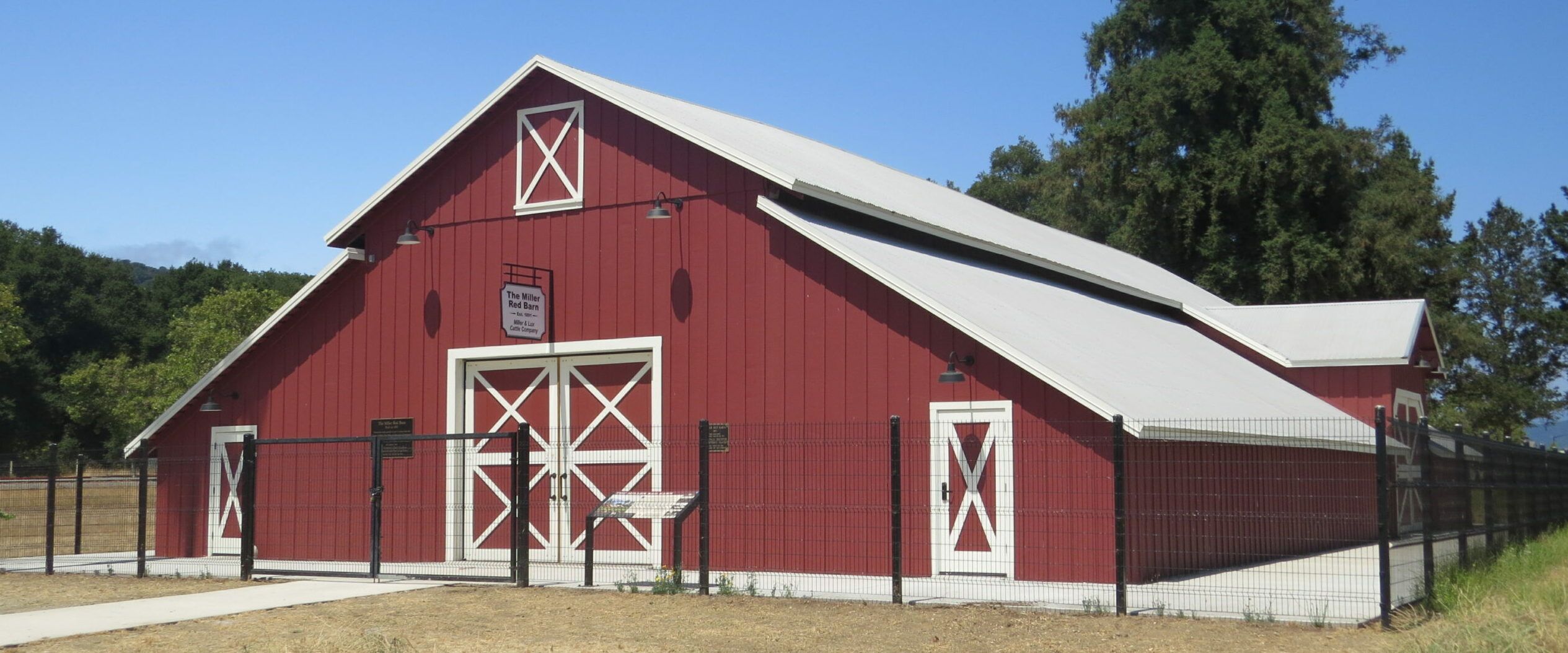Collection of prune box-ends donated by Gilroyan Al Gagliardi
![]()

The Miller Red Barn restoration began in 2014 and now 10 years later is a repository for the South Valley’s agricultural heritage. Photo by Marty Cheek
By Calvin Nuttall
Standing proudly in Gilroy’s Christmas Hill Park, the Miller Red Barn serves as an idyllic monument to the region’s agrarian heritage. Not long ago, the storied structure faced a danger of being demolished. Then a coalition of local history fans joined forces to advocate for its preservation.
 A lifelong history buff and long-time general contractor, Gary Walton had a hand in several prominent historical restoration projects in the area, including the relocation and restoration of the Morgan Hill Elementary School in 2001.
A lifelong history buff and long-time general contractor, Gary Walton had a hand in several prominent historical restoration projects in the area, including the relocation and restoration of the Morgan Hill Elementary School in 2001.
“There’s something different about a wood barn,” said Walton, the president of the Miller Red Barn Association board of directors. “It resonates with people. It’s not an architectural gem — it’s a barn. They’re everywhere. But they’re falling into disrepair. I’m a student of architecture, and of history. I think we tear down way too much stuff, more than we should.”
The decision to demolish the barn came with little fanfare, and almost escaped the community’s notice when it was placed on the Gilroy City Council’s consent calendar in 2014. That’s when Carol DeSantis, a member of the Gilroy Historical Society, brought the barn to Walton’s attention. Together, they assembled a loose group of locals who felt the barn should be preserved for its historical significance. They approached city staff with a plan for its restoration.
“It was in bad shape,” Walton said. “There were a lot of unknowns about the barn, things the city didn’t know, even in their studies.”
The Miller Red Barn Association convinced the city to give them one year to execute their restoration plans. During that time, they raised their first $100,000 to begin the process.
“We did try to preserve what the barn was, so the shape is the same,” Walton said. “A lot of redwood was used. It was full one-dimensional old-growth redwood.”
To learn more of the structure’s secrets, the group visited the Bancroft Museum in Berkeley to dig up the history of Henry Miller. Miller owned Glenn Ranch, the original piece of property on which the barn is located — and from which the city’s first subdivision was carved out many years ago.
 Once among the largest landowners in the United States, Miller became known as the “Cattle King” for his extensive ranchlands in California, Oregon and Nevada. The village of Gilroy served as his home base. A German immigrant who arrived in the U.S. in 1850, Miller worked first as a butcher and later expanded into ranching to construct a vertically-integrated beef business.
Once among the largest landowners in the United States, Miller became known as the “Cattle King” for his extensive ranchlands in California, Oregon and Nevada. The village of Gilroy served as his home base. A German immigrant who arrived in the U.S. in 1850, Miller worked first as a butcher and later expanded into ranching to construct a vertically-integrated beef business.
At the Bancroft Museum, Walton and others found a 1891 story published in the San Jose Mercury News mentioning Henry Miller building a barn in Gilroy. By examining that barn’s construction, Walton determined it was likely Miller built the barn about the same time.
“When we took the roof off, there were square nails,” he explained. “They stopped using those about the turn of the century. So we knew that 1891 was probably in the right ballpark.”
The group secured additional funding from various other sources, including a $300,000 grant from Santa Clara County’s Historical Heritage Commission, an entity established to protect and preserve historical resources.
The group also received funding from then-supervisor Mike Wasserman.
“It was a good year, so the county gave the supervisors a million dollars each to do what they wanted to do,” Walton said. “So we applied, and he gave us another $300,000.”
The project included upgrades to ensure its longevity and bring safety standards up to code. The barn was originally built on dirt, but the group jacked it up to pour a concrete-slab foundation. They also replaced its aging walls with modern materials, using the remnants of the original barn wood as siding to retain the rustic look.
Over the years, the association board realized they really had something special. Seeing it as more than a simple relic, the volunteers transformed the building into a repository for the region’s agricultural history by installing interpretive panels telling the barn’s history and framing it within the region’s broader ranching heritage.
These historical displays include a set of heirlooms curated by the late Al Gagliardi, who died in March. The Gilroyan donated his extensive collection of prune box-end (stenciled with local family names) to the MRBA.
“Al’s collection is more than just an assortment of boxes; it is a living museum that captures the essence of our local history,” Walton said at the exhibit’s dedication Aug. 3. “Through these boxes, we can trace the evolution of farming families, their practices, marketing trends, and the cultural significance of the prune industry. Al has provided us with a window into the past, allowing us to appreciate the roots of our community and the progress we have made.”
Calvin Nuttall is a Morgan Hill-based freelance writer.






